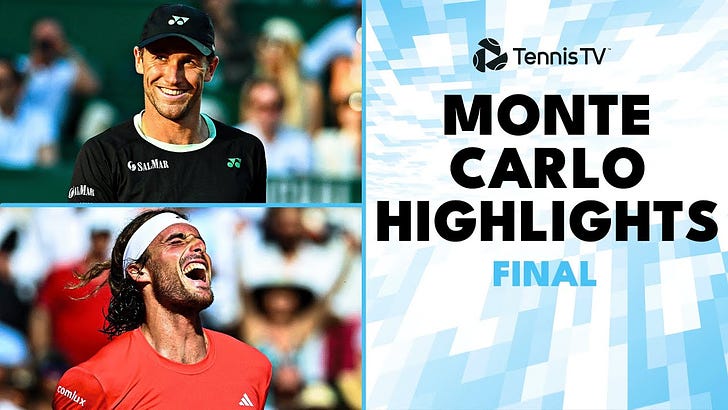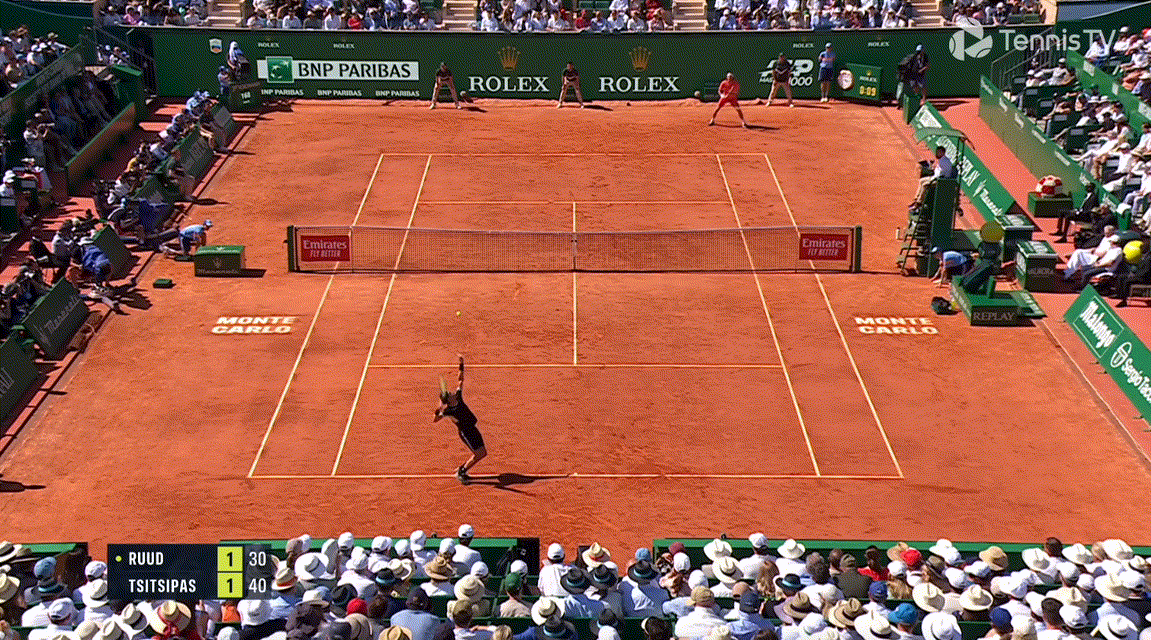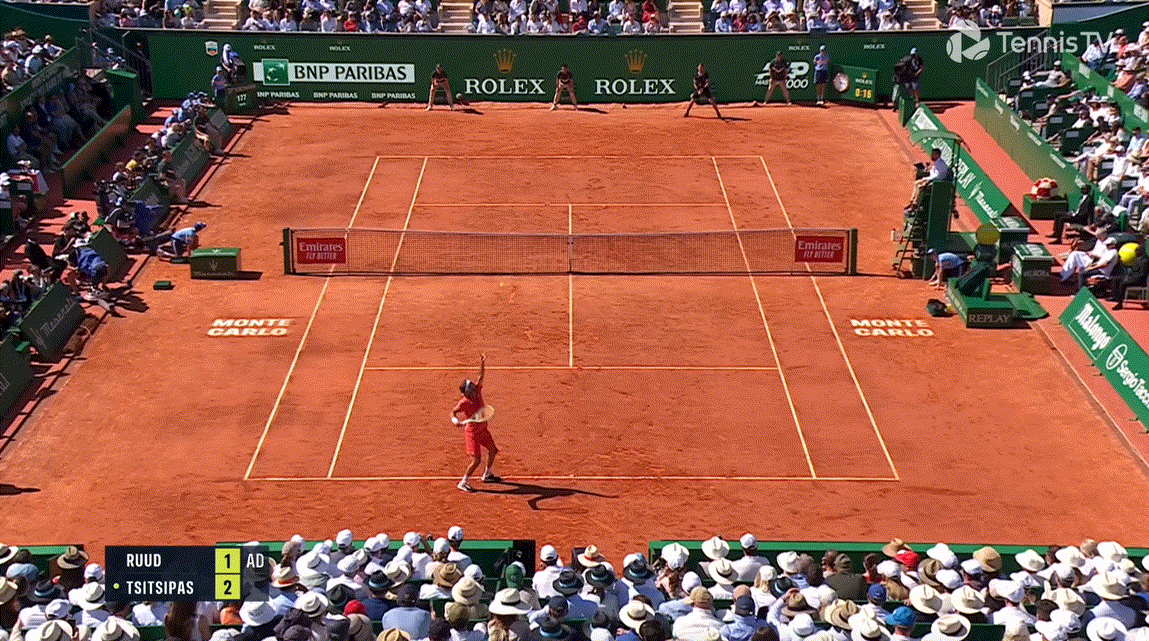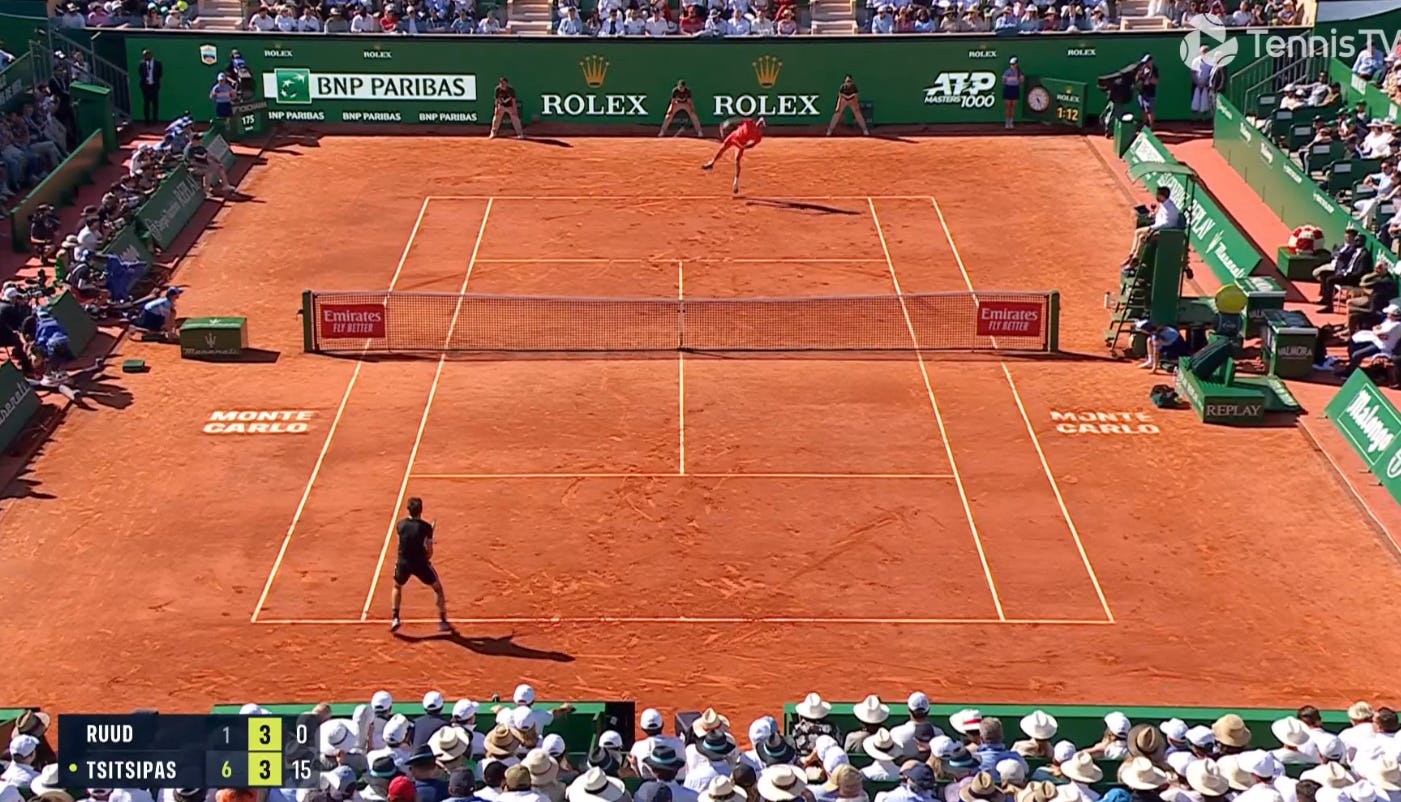Tsitsipas vs Ruud: Monte Carlo Final Recap
inside-in forehands — serve & volley — return angles
Stefanos Tsitsipas defeated Casper Ruud 6/1 6/4 in the final of the Monte Carlo Masters on Sunday to claim his third Masters 1000 title (Monte Carlo 2021, 2022). The win puts Tsitsipas back in the top-10 of the live rankings and brings his H2H with Ruud level at 2-2.
Both men possess powerful and heavy forehands that were instrumental in reaching the final this week. At home on the dirt, Tsitsipas led the field with an 8.9 average.
During Tsitsipas’ semifinal win over Sinner I commented on the Greek’s phenomenal inside-in forehand. The difficulty of the inside-in forehand is the higher net clearance and shorter length of the shot; you need a lot of spin to make it a reliable weapon. The perk is that your opponent is positioned on the backhand side of the baseline to cover for the possibility of an off forehand. Observe where Ruud split-steps left of centre before Tsitsipas takes this forehand inside-in.
Tsitsipas did a phenomenal job finding forehands from deep in his backhand pocket, just like the above example from the alley.
Tsitsipas got the better start, finding his range early and shuffling around the AD-side to create forehands from deep backhand territory. Ruud tried to counter this by taking his forehand hard into the Tsitsipas forehand corner early in the rallies, but he executed poorly in the opening games, misfiring to gift the Greek three break points.
The first break point at 1-1 0-40 was the first time Ruud managed to find the Tsitsipas backhand twice in a row with his forehand. He won that point, but he only found that pattern four times in the first set, in part due to Stef’s great footwork around his backhand.
The third breakpoint was another example of Ruud’s inability to find the Tsitsipas backhand costing him dearly. Ruud’s wide kick serve landed too close to the middle of the box, allowing Tsitsipas to take one shuffle to his left and find another forehand, this time all the way from the Rolex clock. This gave him enough angle to rip his off forehand wider into Ruud’s backhand corner, who’s run-around forehand produced a short ball that the Greek quickly pounced on.
There’s that sharply angled forehand winner that the Greek hits so well. He can break the forehand sideline better than anyone.
One of the unique features of Tsitsipas’ forehand is the extent of his flip; his racquet tip gets a long way inside the line of the ball, perhaps more than any player on tour. Check out the slow motion path from Top Tennis Training:
Here’s a screenshot of just how far back Tsitsipas’ racquet tip often gets1:
Such an extreme in-to-out swing path is ideal for hitting topspin, but it’s perhaps also a reason why he can generate so much spin and power from a fairly compact backswing, as well as find that cross-court forehand so well. This gives him the ability to play attacking and spin-oriented tennis close to the baseline. Compare Ruud’s longer backswing and quieter racquet next to Tsitsipas’ extreme left-to-right action as it drops into the slot:
Anyway, back to the match. Ruud generated a few breaks of his own at 1-2, three of them, to be precise. On two of these he got a look at Tsitsipas’ second serve. On both of these, the Greek rolled his serve down the middle of the court to the Ruud forehand. This meant Ruud had a forehand, but with much less angle to find Stef’s backhand. Coupled with the Greek’s proactive movement, Tsitsipas found his trusty forehand with space to then hit into Ruud’s backhand:
Tsitsipas found so many forehands after his serve. On second serves on the AD side he served down the T often to cut down Ruud’s angles and make it easier to find his forehand. This play also opens up Ruud’s backhand on the Greek’s plus-one ball, as the Norwegian is recovering back to centre.
Tsitsipas broke two more times in the opening set. The first time was largely due to Ruud’s errors in standard forehand patterns. But compounding these problems was the Greek’s ability to find winners from his weakest part of the court. Check out this back foot open-stance down-the-line punch backhand:
I’ve been critical of Stef’s backhand, but it was very impressive today against Ruud’s spin and power.
The backhand down-the-line is the obvious foil when playing forehand hungry players like Tsitsipas and Ruud. The problem for both of them, usually, is that they aren’t particularly strong with that shot. Ruud found a couple of his own in the opening set, but he much prefers to roll a high and heavy backhand crosscourt. Tsitsipas looked very comfortable on return and from the baseline and it’s the best I’ve seen him hit that shot in some time.
Second Set
Ruud lifted his baseline level in the second set, again finding a break point in the opening game, courtesy of the just mentioned backhand down-the-line. When that shot is firing for either man, they are a completely different player.
In response, Tsitsipas serve-and-volleyed twice on his second serve on the Ad-court, catching Rude off-guard from his deep return position:
Returning from this deep gives the server a lot of time to get close to the net for an easier volley.
Tsitsipas would serve-and-volley a few more times in this 7-minute third-game, and on all occasions he won the point convincingly.
At this point in the match, we also saw just how effective Tsitsipas had been at finding his forehand after the serve:
If he wasn’t serving middle to find forehands, he was doing it to ensure a look at a first volley. This play below would make Alcaraz smile:
Even if Ruud got to this drop shot, playing it short ensures your opponent probably has to take a hand off the racquet and hit up to pass you.
In response, Ruud stood up on the second serve the very next point in a bid to rush Tsitsipas on his plus-one and serve-volley tactics:
The problem with this adjustment for Ruud was that his backhand return was now a weaker strike. Tsitsipas took immediate advantage, running Ruud ragged on the 15-0 point, and finding a plus-one backhand down-the-line winner on the 30-0 point; a timely reminder that there are no solutions, only tradeoffs.
However Ruud would come back from 40-0 down in the 3-3 game to earn another break point. The return adjustment was paying off, allowing Ruud to find the Greek’s forehand space from more aggressive parts of the court:
Despite some red-lining baseline hitting, the Greek stood firm, weathering Ruud’s increasingly potent forehand with his own backhand, before finding a forehand to dictate the point. The game proved pivotal, with Ruud failing to capitalise on three break point chances to leave him at 0/8 on that stat. In contrast, Tsitsipas would end up converting on 4/8 chances.
Serving at 4-5 Ruud again opened the game with a loose forehand. It was the story of the day for the Norwegian; the bedrock of his clay game deserted him when he needed it most today. In contrast, Tsitsipas fittingly hitting a forehand winner on his first match point to seal his third Monte Carlo crown and first 1000 title since this same venue in 2022.
A look at the rap sheet.

It was a good reminder of the quality player Tsitsipas is when all cylinders are firing. I think it’s clear that players who can stand up and rush the Greek (Alcaraz, Sinner, Djokovic, Rune) have a better matchup with Tsitsipas than Ruud does, but the Greek’s backhand was rock solid under pressure today, and he will be a threat to anyone if he can keep playing like this for the clay season.
Barcelona, Bucharest, and Munich kick off tomorrow. I’ll be back with a Barcelona final recap next week.
See you in the comments. HC.
This is an extreme example. Most balls won’t be this far inside the line.















82% forehands is the key here. Tsitsipas' bh stood up to pressure (I still think he'd been better off with a two-hander) but not having to hit it very much is what won him this match.
Another key to Tsitsipas' success is how the fh opens up the physicality of the game for him. It can be hard to remember bc of the camera angles, but Tsitsipas is a BEAST. If he'd been born in America, he would be an NBA guard or NFL wide receiver. They would have put 15-20 lbs of muscle on him and given him a helmet. He's so physically impressive and when he can step into the court and come forward he can dominate. When he's able to move around and get the fh, he starts to run more and the space on the court becomes an asset. When he's boxed in hitting bh's, he gets very normal.